Photographs: Reuters Ashok Basu
The listless administrative machinery urgently needs to be galvanised to revive the power sector. Ashok Basu underlines a possible agenda to go about it
A vibrant electricity sector is a pre-requisite for socio-economic development.
Unfortunately, the last few years in India have seen investor confidence in the sector eroded by allegations of corruption and favouritism in coal block allocations, opacity in fixing domestic gas prices, delays in environment and forest clearances and the unseemly haste by political parties to announce electricity supplies at sub-optimal tariff to selected classes of consumers.
Now, expectations are high that the incoming government will act swiftly to put the sector back on the rails.
This article suggests a credible agenda for action by the new government and its power minister.
. . .
Power sector: What the new government needs to do
Image: The fundamentals of the electricity sector are strong.Photographs: Reuters
First, the positives.
The fundamentals of the electricity sector are strong.
The basic legal, governmental and regulatory framework is in place.
The Electricity Act, 2003 provides the legal structure with emphasis on restructuring state electricity boards, an independent regulatory mechanism, delicensed generation, open access, private entry and competition, trading and consumer protection.
The government has announced the National Electricity, Tariff, Rural Electrification and Integrated Energy policies.
Regulators have streamlined tariff setting, and issued orders for private entry, open access, trading, competitive bidding, grid discipline, market development and promotion of renewables.
. . .
Power sector: What the new government needs to do
Image: Within two months or so, the government should announce its statement of intent, clearly indicating its road map to take the sector forward.Photographs: Reuters
Since knowledge is power, the new minister’s first task should be to familiarise himself quickly with this enabling framework.
Next, within two months or so, the government should announce its statement of intent, clearly indicating its road map to take the sector forward.
Among the government’s immediate priorities, which should be done in the first three to four months, is to finally decide and settle pending contentious issues such as coal block allocation, gas pricing and allocation and environment and forest clearances.
The speedy resolution of these issues would send the clear message that this government means business.
Stakeholder confidence would be restored immediately.
It would trigger fresh flow of funds from banks and financial institutions.
. . .
Power sector: What the new government needs to do
Image: The new government would have to ensure that the 12th Plan target of 119 Gw of additional capacity is fulfilled.Photographs: Reuters
India’s current installed generation capacity is 240 Gw.
The new government would have to ensure that the 12th Plan target of 119 Gw of additional capacity is fulfilled.
Projects would have to be constantly monitored, and time and cost overruns should not be tolerated.
A Crisis Resolution Group should be set up with the minister as chairman and stakeholders concerned as members, to resolve pending issues on the spot, and enable quick financial closure and completion of projects.
The new government also needs to find the right fuel mix for energy security.
Although 60 per cent of India’s energy will continue to be thermal, India will have to import 90 per cent of its oil, 50 per cent of its gas and 45 per cent of its coal to meet its energy requirements by 2030.
. . .
Power sector: What the new government needs to do
Image: Coal supplies for ultra mega power projects have to be finalised and clearance for hydro-electric projects should be on the fast track.Photographs: Reuters
Clean energy sources like hydro and renewables like solar, wind, biomass and so on have to be given adequate fiscal and financial incentives.
Coal supplies for ultra mega power projects have to be finalised and clearance for hydro-electric projects should be on the fast track.
The universal supply obligation has very little relevance when 20 per cent of India’s villages still have no access to electricity.
The government’s role does not end merely by facilitating power supply to a few prominent places in the village.
The target should be to electrify every village household.
This would mean a paradigm shift in the Rural Electrification Policy.
. . .
Power sector: What the new government needs to do
Image: Engineers inspect electric transmission lines at Adani Power Company thermal power plant at Mundra in Gujarat.Photographs: Amit Dave/Reuters
Since grid-connected power supply to villages is not always a viable proposition, the government must incentivise off-grid applications and use of local resources that involve franchisees, co-operatives and other village institutions.
This new policy should be implemented within two years.
The government also needs to accord high priority to distribution reform.
The aim should be to provide assured supply of good quality power round the clock at an affordable price.
Electricity supply is not charity.
The law mandates the regulator to fix the tariff to enable the investor to recover its prudent costs and earn reasonable return on investment.
. . .
Power sector: What the new government needs to do
Photographs: Reuters
Whenever a state government considers it politically expedient to supply power at less than the tariff fixed by the regulator, the Act requires the state government to provide the distribution company (discom) an upfront subsidy to fully compensate the loss.
In practice, this subsidy has been rarely provided.
State governments have also been instructing the discoms not to file petitions before the regulator for increase of tariff.
To soften the impact of a realistic tariff hike, the regulators have been forced to allow a moderate increase, and convert the balance revenue gap into regulatory assets to be liquidated in future years.
‘Open access’ has been a non-starter since state governments are not willing to allow the consumers to move away from their discoms.
Consequently, the distribution sector has deteriorated.
. . .
Power sector: What the new government needs to do
Image: Discoms should be allowed to realise the full tariff determined by the regulator.Photographs: Reuters
A discom today recovers the cost of two units of power for every three units distributed. With total accumulated losses of Rs 2 lakh crore (Rs 2 trillion), unpaid borrowings of other Rs 2 lakh crore (Rs 2 trillion) and regulatory assets of Rs 2.5 lakh crore (Rs 2.5 trillion), the discoms have virtually become non-performing assets.
The Centre must take the initiative to reverse this trend. Discoms should be allowed to realise the full tariff determined by the regulator.
Half the discoms’ borrowing should be converted into state-government guaranteed bonds, and the remaining half should be rescheduled by the banks against time-bound milestone-based reform measures to be taken by the discoms.
To close the revenue gap, the states must allow the amortisation of regulatory assets over five to eight years.
. . .
Power sector: What the new government needs to do
Image: Labourers remove kites tangled up in electric power cables in Ahmedabad.Photographs: Amit Dave/Reuters
The independence and autonomy of the state regulators must be respected.
The Central Electricity Regulatory Commission’s mandate is that grid frequency must be maintained between 49.9 and 50.05 Hz.
There is a reward/penalty mechanism for discoms, which help maintain grid discipline, and those which disturb it.
Due to political and other expediencies, discoms have been overdrawing power at high frequency, causing serious grid disturbance.
The massive grid collapse across India in 2012 is a case in point.
The Centre must counsel the states against resorting to such unfair practice, and also to put in place islanding facilities, insulators, relays, and so on to ensure that grid disturbance is localised and does not have a cascading effect.
. . .
Power sector: What the new government needs to do
Image: Workers install cables on electric pylon in Ahmedabad.Photographs: Amit Dave/Reuters
‘Electricity’ is a concurrent subject in our Constitution, the Centre and the states are equal partners in its development.
Issues such as distribution reform, grid discipline, open access, rural electrification, empowering state regulators and so on are primarily the business of state governments. However, the Union government can play a decisive role as an enabler and facilitator.
It is essential for the Union power minister to call a meeting of state power ministers within the first three months, to work out a broad consensus on power reforms that can be implemented within a specific time frame.
The new government must quickly demonstrate its political power and rejuvenate the listless administrative machinery.
There are no soft options.
. . .
Ashok Basu is former Union Power Secretary & Chairman, Central Electricity Regulatory Commission

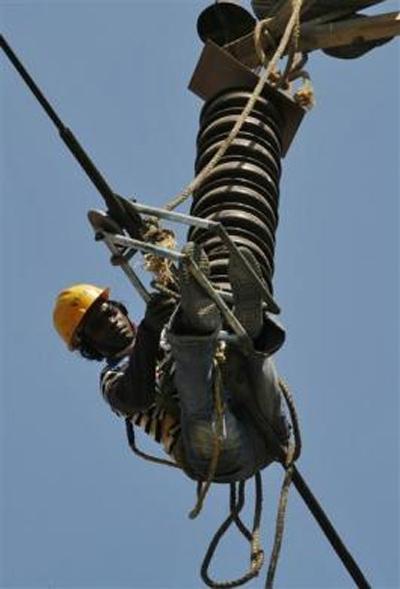
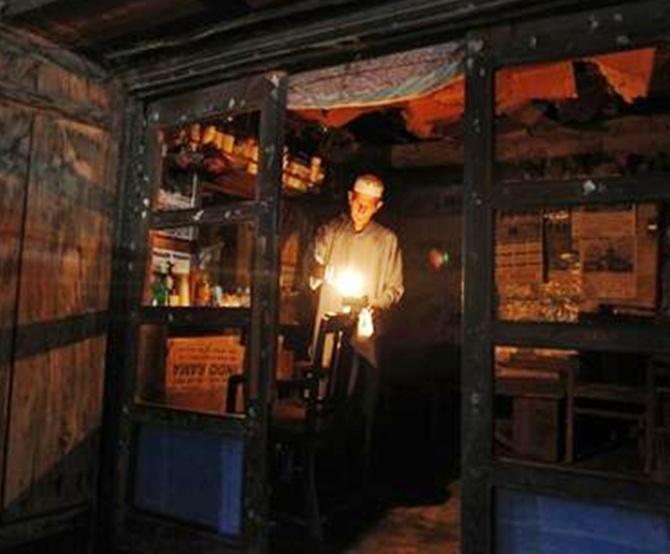


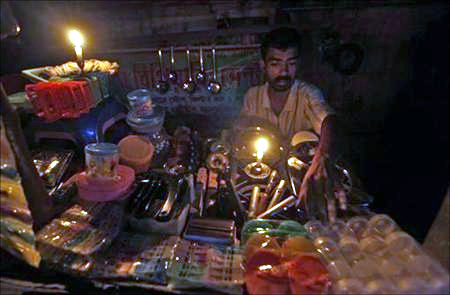

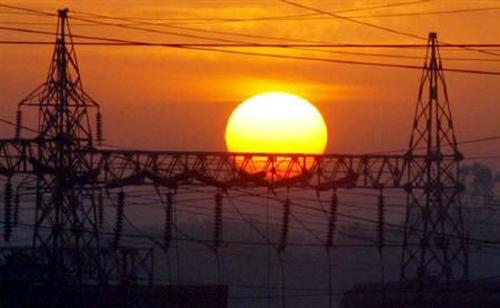
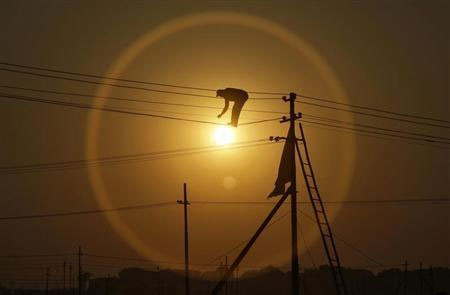
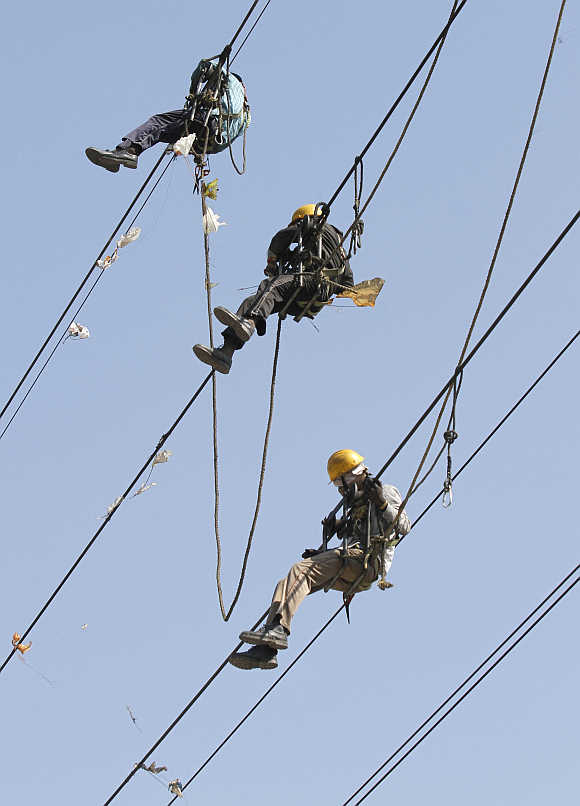
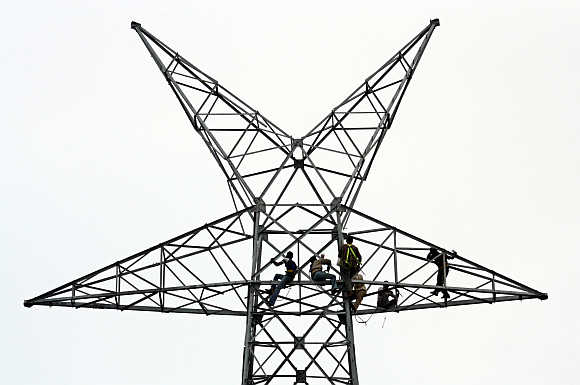

article